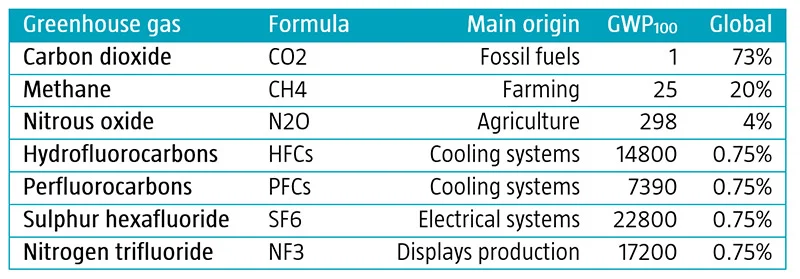When speaking about carbon emissions we often mean carbon dioxide equivalents instead of just carbon dioxide. But what does this ‘equivalent’ exactly mean? Well, carbon dioxide is not the only molecule contributing to global warming – there are many different molecules that possess greenhouse gas effects. This memo explains how this ‘equivalent’ is used to measure the effects of many different greenhouse gases together.
In the Kyoto protocol (1997), initially six different greenhouse gases were considered. These are shown as the first six gases in the table below. In 2013, nitrogen trifluoride was added as the seventh official greenhouse gas. Besides the gases in the table, ozone and water vapor are also important greenhouse gases. However, these are not included in the greenhouse gas protocol as their presence in the atmosphere is only limitedly influenced by mankind.

The different greenhouse gases in the table all have the ability to increase the temperature of the planet, though their impact substantially differs. To make the impact of the different greenhouse gases on the temperature comparable, the global warming potential (GWP) score was introduced.1 The GWP of a gas depends on how much heat the gas is able to absorb, and how the gas’s concentration decays over time.
I follow the market standard and look at warming potentials over a 100-year period. This is usually denoted as GWP100 and reported in the table for the seven Kyoto gases. The GWP is always expressed relative to carbon dioxide, of which the GWP is normalized to 1. For instance, methane has as GWP100 of 25, which implies that a ton of methane has 25 times higher effect on global warming than a ton of carbon dioxide over a 100-year period. When emitted, methane is actually much more than 25 times more potent than CO2, but it’s prevalence in the atmosphere decays much faster than CO2, which can remain in the atmosphere for thousands of years.
Please note the four very potent gases in the table, with SF6 topping the list, being 22,800 times more potent that CO2. These so-called fluorinated gases are thus extremely potent, and their increasing use is considered a rather large risk for future global warming. Much research on alternatives for the use of these gasses is currently being conducted to limit the future use of these gases.
The column ‘Global’ shows how much the seven Kyoto gases contribute to global warming. Carbon dioxide emissions are responsible for 73% of all global warming caused by mankind. Methane and nitrous oxide together account for 24% of global warming. The remaining 3% is caused by the four fluorinated gases.
In its annual survey, the CDP asks companies to break down the total reported scope 1 emissions (in tons of CO2e) into the seven Kyoto gases.2 Companies generally differ quite a lot in the gases they report CO2e figures for. Some companies only report emissions from CO2, while others also include emissions from other gasses, which can make comparisons difficult. For instance, does a lower total CO2e figure imply a cleaner company or is that company just not reporting on all Kyoto gases?
最新のインサイトを受け取る
投資に関する最新情報や専門家の分析を盛り込んだニュースレター(英文)を定期的にお届けします。
Footnotes
1 In this memo I still use the GWP’s from the IPCC 4th assessment report, although the 6th IPCC report with new GWP values has recently been published. Note that GWP’s are hard to estimate and vary through time as estimation methods improve.
2 Carbon Disclosure Project (CDP) is the organization that collects reported emission data of companies.
重要事項
当資料は情報提供を目的として、Robeco Institutional Asset Management B.V.が作成した英文資料、もしくはその英文資料をロベコ・ジャパン株式会社が翻訳したものです。資料中の個別の金融商品の売買の勧誘や推奨等を目的とするものではありません。記載された情報は十分信頼できるものであると考えておりますが、その正確性、完全性を保証するものではありません。意見や見通しはあくまで作成日における弊社の判断に基づくものであり、今後予告なしに変更されることがあります。運用状況、市場動向、意見等は、過去の一時点あるいは過去の一定期間についてのものであり、過去の実績は将来の運用成果を保証または示唆するものではありません。また、記載された投資方針・戦略等は全ての投資家の皆様に適合するとは限りません。当資料は法律、税務、会計面での助言の提供を意図するものではありません。 ご契約に際しては、必要に応じ専門家にご相談の上、最終的なご判断はお客様ご自身でなさるようお願い致します。 運用を行う資産の評価額は、組入有価証券等の価格、金融市場の相場や金利等の変動、及び組入有価証券の発行体の財務状況による信用力等の影響を受けて変動します。また、外貨建資産に投資する場合は為替変動の影響も受けます。運用によって生じた損益は、全て投資家の皆様に帰属します。したがって投資元本や一定の運用成果が保証されているものではなく、投資元本を上回る損失を被ることがあります。弊社が行う金融商品取引業に係る手数料または報酬は、締結される契約の種類や契約資産額により異なるため、当資料において記載せず別途ご提示させて頂く場合があります。具体的な手数料または報酬の金額・計算方法につきましては弊社担当者へお問合せください。 当資料及び記載されている情報、商品に関する権利は弊社に帰属します。したがって、弊社の書面による同意なくしてその全部もしくは一部を複製またはその他の方法で配布することはご遠慮ください。 商号等: ロベコ・ジャパン株式会社 金融商品取引業者 関東財務局長(金商)第2780号 加入協会: 一般社団法人 日本投資顧問業協会


















